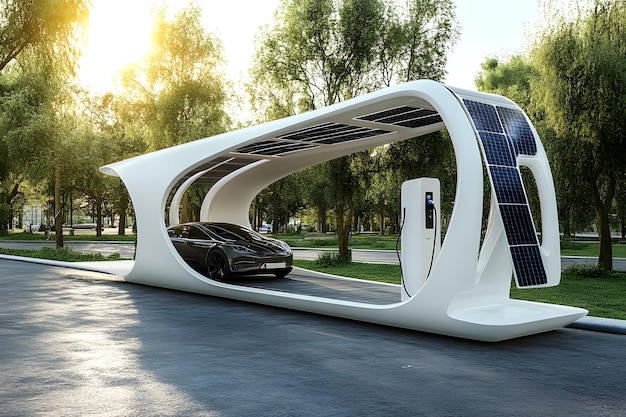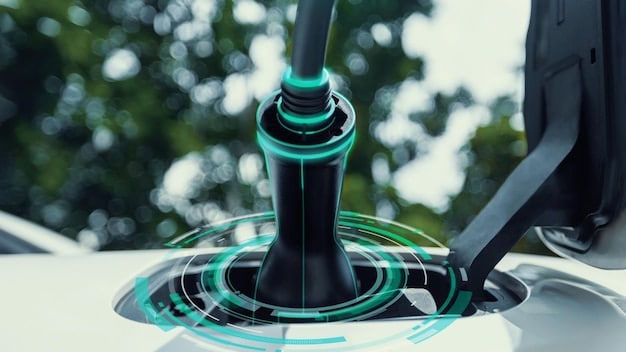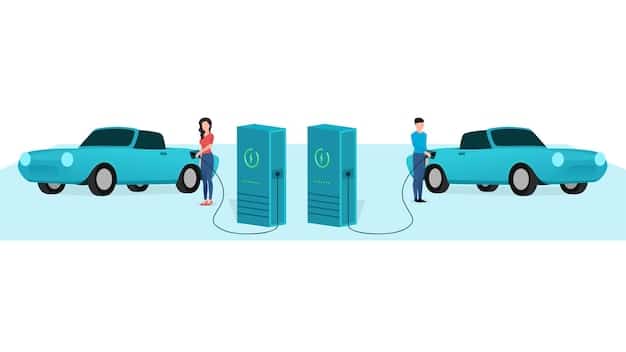Latest Innovations in US Electric Vehicle Charging Technology

Anúncios
The latest innovations in electric vehicle (EV) charging technology in the US include advancements in fast charging, wireless charging, battery swapping, smart charging solutions, and the development of more sophisticated charging infrastructure.
As electric vehicles (EVs) become increasingly popular across the United States, the demand for efficient and accessible charging solutions has surged. The latest innovations in electric vehicle (EV) charging technology in the US are revolutionizing how we power our EVs, making them more convenient and sustainable than ever before.
Anúncios
Advancements in Fast Charging Technology
Fast charging technology is rapidly evolving, significantly reducing the time it takes to charge an electric vehicle. These advancements are crucial for making EVs a more practical option for long-distance travel and daily commutes.
Combined Charging System (CCS)
The Combined Charging System (CCS) is becoming a standard for fast charging in the US. It allows for both AC and DC charging, making it versatile for different charging needs.
Anúncios
- Increased Power Delivery: CCS chargers can now deliver up to 350kW, significantly reducing charging times.
- Compatibility: CCS is compatible with a wide range of EVs, making it a popular choice for charging networks.
- Infrastructure Growth: The number of CCS charging stations is steadily increasing across the US.
Tesla Supercharger Network
Tesla’s Supercharger network is another key player in fast charging technology. Tesla continues to innovate, pushing the boundaries of charging speed and convenience. However, many states are pushing for Tesla to offer a universal charging port, which would allow for more access.

Fast charging technology is transforming the EV landscape, making it easier and faster to keep electric vehicles on the road. The development and expansion of these charging networks are essential for supporting the growth of the EV market in the US.
Wireless Charging Solutions
Wireless charging offers a convenient and hands-free way to charge electric vehicles. This technology is gaining traction, with several companies developing innovative solutions for both static and dynamic charging.
Static Wireless Charging
Static wireless charging involves parking an EV over a charging pad, which then transfers electricity wirelessly to the vehicle’s battery. This method is ideal for home and workplace charging.
- Convenience: Eliminates the need for cables and plugs.
- Ease of Use: Simple and intuitive charging process.
- Growing Availability: More charging pads are becoming available for residential and commercial use.
Dynamic Wireless Charging
Dynamic wireless charging is a more ambitious technology that allows EVs to charge while in motion. This could potentially eliminate range anxiety and reduce the need for large batteries.
Wireless charging technology promises to revolutionize how we charge electric vehicles, offering a seamless and convenient alternative to traditional plug-in charging. As the technology matures, we can expect to see more widespread adoption in the US.
Battery Swapping Technology
Battery swapping is an innovative approach that involves replacing a depleted EV battery with a fully charged one in a matter of minutes. While not as widespread as other charging methods, it offers a potentially faster alternative.
Nio’s Battery Swapping Stations
Nio, a Chinese EV manufacturer, has pioneered battery swapping technology. Their stations allow drivers to quickly swap their batteries, providing a full charge in just a few minutes.
- Speed: Battery swapping is significantly faster than traditional charging.
- Convenience: Eliminates the need to wait for charging.
- Infrastructure Challenges: Requires specialized stations and standardized batteries.
Potential for Standardization
One of the challenges for battery swapping is the lack of standardization. If battery designs could be standardized, it could become a more practical solution for a wider range of EVs.

Battery swapping technology offers a unique approach to EV charging, providing a quick and convenient alternative. While it faces challenges related to infrastructure and standardization, it has the potential to play a significant role in the future of EV charging.
Smart Charging Solutions
Smart charging solutions utilize data and connectivity to optimize the charging process. These technologies can help reduce energy costs, improve grid stability, and enhance the overall EV charging experience.
Vehicle-to-Grid (V2G) Technology
Vehicle-to-Grid (V2G) technology allows EVs to not only draw power from the grid but also send power back to it. This can help stabilize the grid and reduce peak demand.
Smart charging technologies are crucial for integrating EVs into the energy ecosystem. By optimizing charging schedules and enabling bidirectional energy flow, these innovations can help create a more sustainable and efficient transportation system.
Innovations in Charging Infrastructure
The development of robust and accessible charging infrastructure is essential for supporting the growth of the EV market. Several innovations are focused on expanding and improving the charging infrastructure in the US.
Public Charging Networks
Companies like Electrify America and ChargePoint are investing heavily in building out public charging networks across the US. These networks provide fast and reliable charging options for EV drivers on the go.
- Strategic Placement: Charging stations are being strategically placed along major highways and in urban areas.
- Increased Availability: The number of public charging stations is rapidly increasing.
- Improved Reliability: Efforts are being made to improve the reliability and uptime of charging stations.
Home Charging Solutions
Home charging is a convenient and cost-effective option for EV owners. Several companies offer home charging solutions, including Level 2 chargers and smart charging systems.
Innovations in charging infrastructure are critical for making EV ownership more convenient and accessible. By expanding public charging networks and improving home charging solutions, the US is paving the way for a more sustainable transportation future.
Addressing Challenges and Future Trends
While significant progress has been made in EV charging technology, several challenges remain. Addressing these challenges and staying ahead of future trends will be crucial for the continued growth of the EV market.
Standardization and Interoperability
Standardization and interoperability are key issues that need to be addressed. A lack of standardization can create confusion and inconvenience for EV owners.
- Universal Charging Standards: Efforts are being made to establish universal charging standards.
- Interoperable Charging Networks: Ensuring that different charging networks are interoperable is essential.
- Streamlined Payment Systems: Simplifying payment systems for EV charging is also a priority.
Renewable Energy Integration
Integrating renewable energy sources with EV charging is another important trend. This can help reduce the carbon footprint of EVs and make them even more sustainable.
Addressing these challenges and embracing future trends will be essential for realizing the full potential of electric vehicles. By focusing on standardization, renewable energy integration, and advanced technologies, the US can continue to lead the way in EV innovation.
| Key Innovation | Brief Description |
|---|---|
| ⚡ Fast Charging | Reduces charging times significantly using technologies like CCS and Tesla Superchargers. |
| 🔋 Battery Swapping | Offers quick battery replacement, providing a fully charged battery in minutes. |
| 🌐 Smart Charging | Optimizes charging using data and connectivity, including V2G technology. |
| 🔌 Wireless Charging | Provides convenient, cable-free charging solutions for static and dynamic charging. |
Frequently Asked Questions
▼
The fastest EV charging technology available is 350kW DC fast charging, utilizing systems like CCS. These chargers can add significant range to an EV in a short amount of time, making long-distance travel more feasible.
▼
Wireless EV charging involves parking the vehicle over a charging pad, which uses electromagnetic fields to transfer energy to the vehicle’s battery. This eliminates the need for cables and provides a convenient charging solution.
▼
Smart charging offers several benefits, including reduced energy costs, improved grid stability, and optimized charging schedules. V2G technology allows EVs to contribute energy back to the grid during peak demand, enhancing sustainability.
▼
Battery swapping stations are not yet common in the US, but they are gaining attention as a potential alternative to traditional charging. Companies like Nio are pioneering this technology, offering fully charged batteries in minutes.
▼
The main challenges include the high costs of installing charging stations, the need for standardization across different charging networks, and ensuring the reliability and uptime of charging stations. Addressing these challenges is crucial for widespread EV adoption.
Conclusion
The **latest innovations in electric vehicle (EV) charging technology in the US** are paving the way for a more sustainable and convenient transportation future. From advancements in fast charging and wireless technology to the development of smart charging solutions and robust infrastructure, these innovations are making EV ownership more accessible and practical than ever before.





